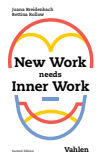New Work needs Inner Work
A handbook for companies on the way to self-organisation
Zusammenfassung
A handbook for organisations on the way to self-organisation
Most approaches to introducing self-management, agile forms of work, and “teal organisations” are doomed to failure. After five years of extensive experience with new forms of leadership, we have seen this process happen over and over again. Most of the time, this is because teams focus exclusively on the external, visible dimension of change.
However, any external change in structures and processes must necessarily be accompanied by an internal transformation. For that reason, this book is particularly dedicated to the “inner innovation” of teams. By this we mean the way that employees and teams can mature and grow in order to shape the complex, flexible, and accelerating world around them with competence and purpose.
New Work needs Inner Work is a practice-oriented manual in which we describe, step-by-step, how to introduce self-management into a team or company. We combine the perspectives of the entrepreneur (Joana, betterplace.org and betterplace lab) and the coach (Bettina). This combination allows us to use organisational principles, as well as concrete examples and exercises, to explore which competencies are important for reducing hierarchies and working flexibly and meaningfully.
This first English edition was enabled by Ashoka – to spread the message that social change requires deep inner work and new ways of leadership.
The Authors
Joana Breidenbach is founder of Germany’s largest donation platform betterplace.org and the Think-and-Do-Tank betterplace lab.
Bettina Rollow develops organisational and leadership forms, e. g. with betterplace lab and Ashoka Germany.
- Kapitel Ausklappen | EinklappenSeiten
- I–X Titelei/Inhaltsverzeichnis I–X
- 1–14 Chapter 1 From hierarchy to the development of potential 1–14
- Organisational development in the digital age
- Why Inner Work?
- Bettina’s journey
- Joana’s starting point
- How does one become a self-organised, holistic enterprise?
- Who is this book for?
- Principles as touchstones for navigation
- Popular misunderstandings
- 15–24 Chapter 2 Outside and Inside 15–24
- First assess your situation, then change
- What does an organisation consist of?
- Change in organisations
- 25–36 Chapter 3 Instruments for internal navigation 25–36
- The individual inner dimension
- Needs, values and interests
- Learning in the inspiration zone
- The collective inner dimension
- How can organisational structures become more fluid?
- 37–46 Chapter 4 Assessing the current situation: Leading and cooperating 37–46
- Basic elements of good leadership
- How does psychological safety arise?
- Leadership in different value systems
- 47–52 Chapter 5 New Work as avoidance 47–52
- The challenges of transferring power
- 53–62 Chapter 6 Escape or inspiration? 53–62
- Anchoring theory in practice
- Where does this motivation come from?
- Confronting tensions consciously
- The inside and outside of push effects
- Inspiration for the next step – pull effects
- Know your competencies
- 63–80 Chapter 7 Inner clarity and the big picture 63–80
- Good sensors as a foundation for self-organisation
- Appearing as a whole human being
- Self-reflection and self-contact
- I can do this. You can’t do this
- Empathy, co-creation, feedback and conflict
- Meta-reflection, multiperspectivity and the big picture
- Why is meta-reflection so important?
- Negative consequences of lacking multiperspectivity
- 81–88 Chapter 8 The equilibrium between reflection and implementation 81–88
- Reflection is not an end in itself
- The competence of manifestation
- Temporary competency-based hierarchies
- Self-responsibility
- 89–115 Chapter 9 Redesigning the organisation 89–115
- How the organisation has changed so far
- The next steps
- Parameters and product: clarifying requirements
- Team: Defining guiding values
- New structures and processes
- Guiding questions and principles for a new model of leadership and cooperation
- Transfer of power and responsibility
- 116–116 Epilogue 116–116
- 117–118 Catalogue of questions for self-organisation 117–118
- 119–136 Exercises 119–136
- 137–138 References 137–138


